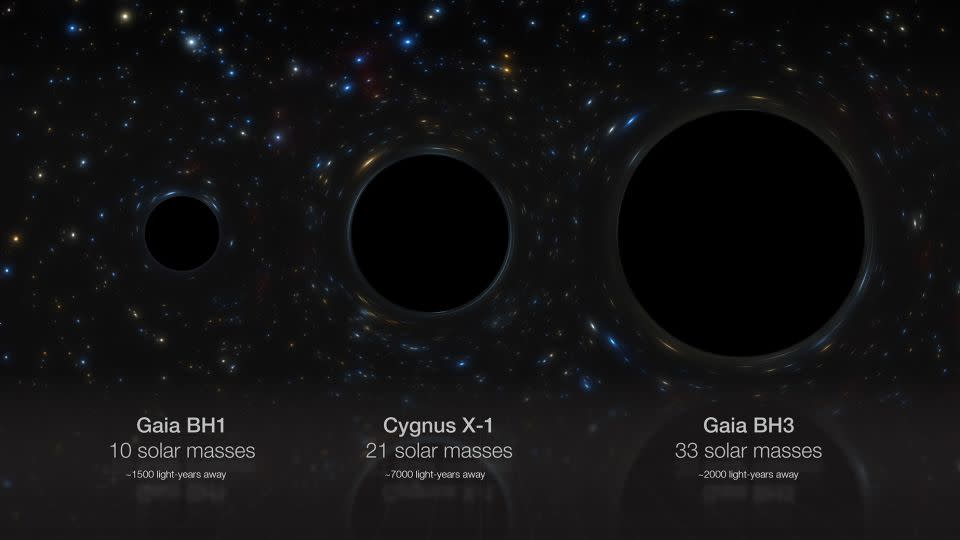Sign up for CNN’s Wonder Theory science newsletter. Explore the universe with news about fascinating discoveries, scientific advancements and more.
Astronomers have identified the largest known stellar black hole in the Milky Way galaxy after detecting an unusual wobble in space.
The “sleeping giant,” called Gaia BH3, has a mass almost 33 times that of our sun and is located 1,926 light-years away in the constellation Aquila, making it the second closest known black hole to Earth. . The nearest black hole is Gaia BH1, which is about 1,500 light-years away and has a mass almost 10 times that of our sun.
Astronomers discovered the black hole while scanning observations taken by the European Space Agency’s Gaia space telescope for data that will soon be available to the scientific community. The researchers didn’t expect to find anything, but a strange motion caused by Gaia BH3’s gravitational impact on a nearby companion caught their attention.
Many “sleeping” black holes don’t have a nearby companion to devour, so they’re much harder to spot and don’t produce any light. But other stellar black holes pull material from companion stars, and this exchange of material releases bright X-rays that can be detected by telescopes.
The wobbling motion of an old giant star in the constellation Aquila has revealed it orbital dancing with a dormant black hole, the third dormant black hole detected by Gaia.
Researchers used the European Southern Observatory’s Very Large Telescope in Chile’s Atacama Desert and other ground-based observatories to confirm the mass of Gaia BH3, and their work also offered new clues about how such massive black holes arise. The findings were published Tuesday in the journal Astronomy and Astrophysics.
“No one expected to find a high-mass black hole lurking nearby and hitherto undetected,” said study lead author Pasquale Panuzzo, an astronomer at the Paris Observatory, part of France’s National Center for Scientific Research, and a member of the Gaia collaboration. , in a statement. “This is the kind of discovery you make once in your research life.”
Secrets of ancient stars
The title of largest black hole in our galaxy will always belong to Sagittarius A*, the supermassive black hole at the center of the Milky Way with a mass approximately 4 million times that of the Sun. supermassive black hole rather than stellar black hole.
The process by which supermassive black holes form is not fully understood, but one theory suggests that it occurs when large cosmic clouds collapse. Stellar black holes form when massive stars die. So Gaia BH3 is the largest black hole in our galaxy, formed from the death of a massive star.
Stellar black holes observed in the Milky Way galaxy have, on average, about 10 times the mass of the Sun. Until the discovery of Gaia BH3, the largest known stellar black hole in our galaxy was Cygnus X-1, with a mass 21 times that of the Sun. While Gaia BH3 is an extraordinary discovery in our galaxy by astronomers’ standards, it is similar in mass to objects found in very distant galaxies.

Scientists believe that stellar black holes with masses like Gaia BH3 form as a result of the collapse of metal-poor stars. It is thought that these stars, which contain hydrogen and helium as their heaviest elements, lose less mass throughout their lives, thus containing more matter at their ends, which may lead to the formation of a high-mass black hole.
But until they found Gaia BH3, astronomers had found no evidence directly linking high-mass black holes to metal-poor stars.
Paired stars tend to be similar in composition, the study’s authors said. Consistent with expectations, the researchers found that the star orbiting Gaia BH3 is poor in metals; This means it is probably the same star that formed Gaia BH3.
“What struck me is that the chemical composition of the companion is similar to what we find in older metal-poor stars in the galaxy,” study author Elisabetta Caffau, a Gaia collaboration fellow at the Observatoire de Paris, said in a statement.
The star orbiting Gaia BH3 likely formed in the first 2 billion years after the big bang that created the universe 13.8 billion years ago. The star’s orbit, which moves in the opposite direction to most stars in the Milky Way’s galactic disk, indicates that it was part of a small galaxy that merged with the Milky Way more than 8 billion years ago.
The team hopes the research will now allow other astronomers to study the massive black hole and uncover more of its secrets without having to wait for the rest of the Gaia data, scheduled to be released in late 2025.
“It is impressive to see Gaia’s transformative impact on astronomy and astrophysics,” European Space Agency science director Carole Mundell said in a statement. “Their discovery reaches far beyond the mission’s primary goal, which was to create an extraordinarily precise, multidimensional map of more than a billion stars across the Milky Way.”
For more CNN news and newsletters, create an account at CNN.com